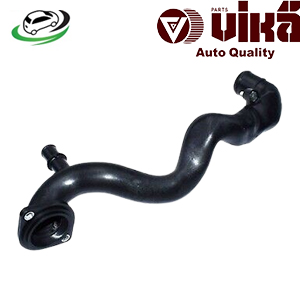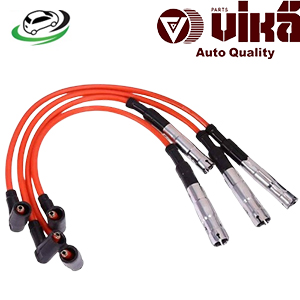-10%
Get AUDI A3 (8L1)/ A4 B5 (8D2)/ A4 B6 (8E2)/ A4 B7 (8EC)/ A6 C5 (4B2)/ TT (8N3) / VW Bora I (1J2)/ Golf IV (1J1)/ Passat B5.5 (3B3) Crankcase Breather Vent Purge Valve 06A129101A
The crankcase breather vent purge valve is a device that manages the pressure and ventilation of the crankcase by releasing excess gases from the engine’s crankcase into the intake manifold, where they are burned as part of the combustion process. It is part of the larger Positive Crankcase Ventilation (PCV) system, which is responsible for recycling blow-by gases to minimize emissions and maintain optimal engine pressure.
In a combustion engine, some gases known as “blow-by” escape past the piston rings into the crankcase. These gases, made up of unburnt fuel, water vapor, and combustion byproducts, increase pressure in the crankcase, which can damage engine seals, gaskets, and reduce engine efficiency. The crankcase breather vent purge valve controls this buildup of pressure and directs the gases back into the engine for combustion, thus improving emissions control and maintaining engine health.
2. How Does the Crankcase Breather Vent Purge Valve Work?
The crankcase breather vent purge valve works as part of the PCV system, which consists of hoses, valves, and filters designed to manage crankcase ventilation. Here’s how the valve operates within the system:
1. Blow-by Gases Enter the Crankcase
- During combustion, gases slip past the piston rings and enter the crankcase. These gases consist of unburnt fuel, water vapor, and other combustion byproducts, which must be vented from the crankcase to avoid pressure buildup.
2. Valve Regulation
- The crankcase breather vent purge valve acts as a controlled gateway that regulates the pressure within the crankcase by allowing the excess gases to escape into the engine’s intake manifold. This process ensures the crankcase pressure is kept in check, preventing over-pressurization, which could lead to oil leaks or engine damage.
3. Recirculating Gases into the Intake Manifold
- The gases from the crankcase are routed back into the engine through the intake manifold via the purge valve. These gases are reintroduced into the combustion process, reducing emissions by burning the blow-by gases that would otherwise be vented into the atmosphere.
4. Preventing Oil Contamination
- By controlling the flow of gases, the crankcase breather vent purge valve prevents oil in the crankcase from becoming contaminated with fuel and combustion byproducts. Clean oil maintains its lubricating properties for a longer period, which helps extend the life of the engine.
3. Benefits of the Crankcase Breather Vent Purge Valve
The crankcase breather vent purge valve offers several key benefits to vehicle performance and emissions control. Some of the most important advantages include:
1. Reduced Emissions
- By recirculating crankcase gases back into the intake manifold for combustion, the valve significantly reduces harmful emissions that would otherwise escape into the atmosphere. This system helps vehicles comply with environmental regulations and lowers the carbon footprint.
2. Improved Engine Performance
- The valve helps maintain optimal crankcase pressure, preventing excessive pressure that could lead to oil leaks or reduced engine efficiency. A well-functioning breather vent purge valve contributes to smoother engine performance, better fuel efficiency, and extended engine life.
3. Enhanced Fuel Economy
- By allowing blow-by gases to be re-burnt in the combustion chamber, the crankcase breather vent purge valve helps improve overall fuel efficiency. Recycling these gases ensures that the fuel is used more effectively, which results in lower fuel consumption.
4. Prevention of Oil Leaks
- Excessive pressure in the crankcase can cause oil to leak through seals and gaskets, which can lead to engine damage. By regulating the pressure, the crankcase breather vent purge valve prevents oil leaks and minimizes the risk of mechanical issues caused by improper pressure management.
5. Extended Engine Life
- Proper ventilation of the crankcase helps maintain the quality of the engine oil by preventing contamination with fuel and combustion byproducts. Clean oil allows for better lubrication, reduces wear on engine components, and extends the life of the engine.
4. Common Issues with the Crankcase Breather Vent Purge Valve
Over time, the crankcase breather vent purge valve can experience wear and tear, leading to malfunctions. Here are some common issues that may arise with the valve:
1. Clogged or Blocked Valve
- The valve may become clogged with oil sludge, dirt, or carbon deposits, preventing it from operating properly. A clogged valve can result in excessive crankcase pressure, leading to oil leaks, reduced engine efficiency, or increased emissions.
2. Stuck Valve
- A stuck valve can cause the PCV system to malfunction. If the valve remains closed, it can trap blow-by gases in the crankcase, leading to increased pressure. If the valve remains open, it can allow too much air into the engine, leading to rough idling or misfires.
3. Oil Contamination
- If the breather vent purge valve fails, it may allow oil to be sucked into the intake manifold, leading to oil contamination of the air-fuel mixture. This can result in poor engine performance, excessive smoke from the exhaust, or fouled spark plugs.
4. Increased Fuel Consumption
- A malfunctioning valve can affect the air-fuel mixture by allowing too much air or gas into the intake manifold, which can increase fuel consumption and decrease fuel economy.
5. Check Engine Light
- If the valve fails, it can trigger the vehicle’s onboard diagnostic system to illuminate the check engine light. This is often accompanied by rough idling, poor acceleration, or unusual exhaust emissions.
5. Signs of a Failing Crankcase Breather Vent Purge Valve
Detecting a failing crankcase breather vent purge valve early can prevent further damage to the engine. Here are some common symptoms of a malfunctioning valve:
- Excessive Oil Leaks: A faulty valve may lead to excessive pressure buildup in the crankcase, causing oil to leak from seals and gaskets.
- Poor Engine Performance: If the valve is clogged or stuck, it can affect the engine’s air-fuel mixture, leading to rough idling, poor acceleration, or misfires.
- Increased Exhaust Smoke: A malfunctioning valve may cause oil to be drawn into the intake manifold, resulting in excessive smoke from the exhaust.
- Decreased Fuel Efficiency: A failing valve can lead to an improper air-fuel mixture, increasing fuel consumption.
- Check Engine Light: A faulty crankcase breather vent purge valve can trigger the check engine light, indicating an issue with the PCV system.
6. Maintenance and Care for the Crankcase Breather Vent Purge Valve
Proper maintenance of the crankcase breather vent purge valve can help ensure the long-term health of your engine and prevent common issues. Here are some maintenance tips:
1. Regular Inspection
- Periodically inspect the valve and the PCV system for signs of wear, clogs, or leaks. Check for excessive oil around the valve, which could indicate a malfunction.
2. Cleaning the Valve
- If the valve becomes clogged with carbon deposits or oil sludge, it can sometimes be cleaned rather than replaced. Cleaning the valve can restore its functionality and prevent more serious problems down the line.
3. Replace When Necessary
- Crankcase breather vent purge valves are wear-and-tear components that may need replacement after extended use. Most manufacturers recommend replacing the valve every 50,000 to 100,000 miles, depending on driving conditions and engine type.
4. Use High-Quality Oil
- Using high-quality engine oil and following the recommended oil change intervals can help prevent sludge buildup in the PCV system, ensuring that the crankcase breather vent purge valve operates smoothly.
Conclusion
The crankcase breather vent purge valve is a small but vital component of your vehicle’s engine system. It helps regulate crankcase pressure, reduce harmful emissions, improve engine performance, and extend the life of the engine. Understanding how this valve works, its benefits, and how to maintain it can help you keep your engine running efficiently and avoid costly repairs caused by pressure imbalances or oil leaks. Regular inspections and timely replacements are key to ensuring the longevity and proper functioning of the crankcase breather vent purge valve, contributing to better fuel economy, lower emissions, and improved engine heal
Follow us on Facebook for more parts.




Reviews
Clear filtersThere are no reviews yet.